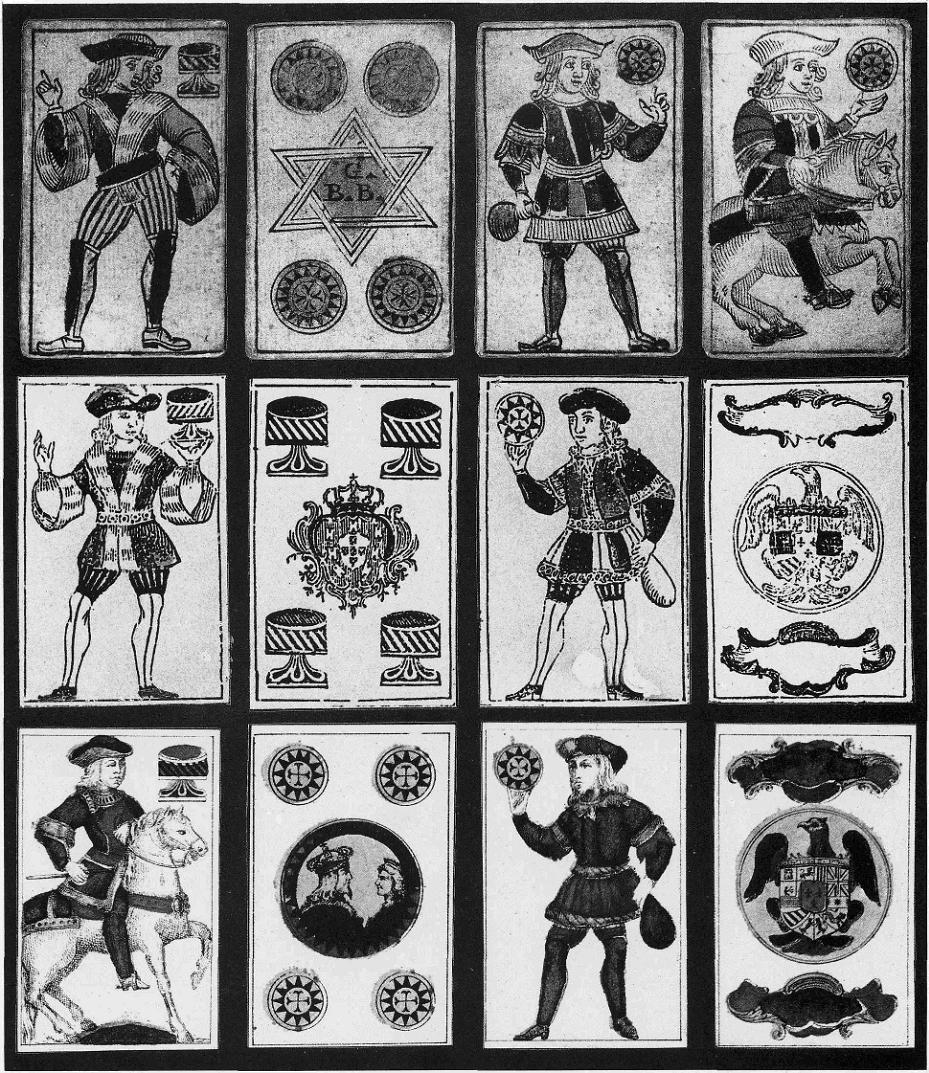

| Suit System: | S |
| Recommended Name: | the Money Bag pattern. |
The only working name for this pattern during investigation has been the Money Bag pattern, from the feature by which it is most frequently recognised.
Although close to the Spanish National pattern, it is too consistent to be just an arbitrary variant of that pattern, and furthermore seems to have no history of use in Spain itself. A few cards display details from Spanish traditions older than the National pattern as we know it. Differences from the National pattern are that the sota of coins carries what appears to be a money-bag (possibly evolved from an earlier hunting-horn), and the ace of coins has a central disc containing the arms of Spain and a distinctive baroque cartouche above and below it which sometimes carries a maker's name. Interlaced triangles forming a six-pointed star appear on the four of coins, and the central coin of the five bears the facing profiles of Ferdinand and lsabel. Both of these features had disappeared from other Spanish cards by the end of the 18th Century (though they continued to be seen on French-made cards intended for the game of aluette). The earliest examples so far found of the money-bag pattern as such are by Italian makers of the middle to late 18th Century. Others, including some from the middle of the 19th Century, are from the Imprensa Nacional of Portugal and carry the inscription Real Fabrica de Lisboa and the Portuguese arms. An anonymous example printed by lithography and stencil is judged to date from about 1870.
The Spanish custom of denoting the suits by breaks in the framelines is sometimes ignored; this is a very strong indication that they were neither made nor intended for use in Spain. It is less easy to say with certainty where their chief destination lay, though to some extent the signs point towards Portugal, for they were certainly officially made there. The earlier Italian sources tend to be those associated with the manufacture of foreign patterns for export, and there is no evidence to suggest that they were actually retained for use in Italy. It is hoped that recording the pattern may lead to more information about it.
The usual four Spanish suits each composed of king, cavalier, sota, and numerals 9 to l or 7 to l, making packs of 48 or 40 cards.
Pedro Bosio (?)Genoa, mid- to late 18th Century. Gio. Bartolomeo Bocciardi (?)Italy, mid- to late 18th Century; Real Fabrica, Lisbon, mid-19th Century; anonymous maker, c.1870.
CATALOGUE OF THE COLLECTION ... OF LADY CHARLOTTE SCHREIBER by Freeman O'Donoghue, British Museum, 1901.
IMPRENSA NACIONAL, Lisbon.
LA SOTA No. 8 (Asociación Española de Coleccionismo e Investigación del Naipe).
MUSEO 'FOURNIER' DE NAIPES, Vitoria-Gasteiz.
UNIVERSITY OF CALIFORNIA, Berkeley.
Several private collections.

| Top row: Gio. Bartolomeo Bocciardi, mid- to late 18th
Century (Martin Jarvis collection). Middle: Real Fabrica de Lisboa, mid-19th Century (Imprensa Nacional, Lisbon). Bottom: Unknown maker (lithography and stencil) c.1870 (Denning collection). |
| The International Playing-Card Society | 4/1996 TD |